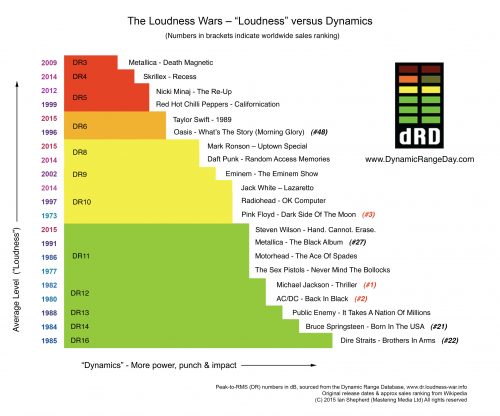Angry Metal-Fi is a series of articles that are cross posted on Angry Metal Guy and Metal-Fi as a collaborative effort to evangelize dynamics in metal.
 Written By: Alex-Fi
Written By: Alex-Fi
I know it can seem like it sometimes, but Metal-Fi’s whole existence isn’t just to criticize every hyper compressed monstrosity that gets released. On the contrary, our main goal is to raise awareness, particularly within the metal community, that production has intrinsic value, and that as a community we need to make a concerted effort to cherish those artists, labels, and engineers who consistently deliver great sounding recordings. But when I claim that production has “value,” what am I really talking about? Is high production value simply a consequence of the DR score under every review, or is it much more than that? So in today’s episode of Angry Metal-Fi, I want to discuss a little bit about DR scores, what they do and don’t tell you, and finally, why they are still important even if they’re ultimately flawed.
Colin Marston of Gorguts fame once told me, “…if a good recording gets a bad mastering job, it can often still sound good. Low dynamics mastering doesn’t necessarily prevent everything from sounding good at all.” I like to call this concept the Marston Rule™, and many of the records that grace these pages are shining examples of that fact. The truth is that most of the metal albums we listen to on a daily basis aren’t that dynamic, yet we still manage to strain our necks listening to them anyway. That’s why to a certain extent, most headbangers, and to be really fair, most music fans in general, don’t really care about the production behind their favorite recording; they see production as simply a means to an end and provided that end is met, life is good.
However, I still believe that there is indeed a point of no return, where terrible production choices really do start to interfere with the source material at hand. But how does that correlate to a record’s DR score? Hint: it doesn’t, at least not in itself.

For instance, Metallica’s Death Magnetic is often cited as one of the worst sounding albums ever recorded, clocking in at a miserable DR3 and constantly serving as the de facto whipping boy for the Loudness War. Yet the recently well-reviewed Ulcerate and Mithras records are not far from the mark, both clocking in at an equally abysmal DR4. Yet to my ears, Death Magnetic sounds a helluva lot worse despite the fact that its DR score is only a point less than the other two.
And what about black metal? A genre notorious for its lo-fi production. In GardenTales‘ great review of the album Fra Doden Fodes Liv by Uburen, he makes the case that although black metal has historically held high fidelity in contempt, it has always been by choice. But today, it’s done mostly out of ignorance or worse still, incompetence. But is it? In fact the three black metal bands he cites as purveyors of high quality production are actually by DR standards prime offenders. Enslaved haven’t released a truly dynamic record since 1997s Eld. Deathspell Omega just released their latest clocking in at paltry DR4. Same is true for the record before it. How can these obviously, highly compressed monstrosities sound good?
Well first off, not all DR scores are created equally. One record’s DR4 can sound a lot more compressed than another’s. And a lot of that has to do with the mix. Case in point, the new Virvum record, which has a master that’s way past the point of no return but is still able to retain a modicum of fidelity through its clean room sounding mix. In fact, I’d argue that though the Vivrum, Ulcerate, and Mithras records all measure DR4, Virvum sounds the best by far. That’s also why to a certain extent, production super villains like Jens Bogren [Boggggggggrrrrrrennnnnnn! – Dave-Fi] are able to compress records to such mediocre levels yet still end up with albums that sound stellar. The man clearly knows how to mix.
 Another failing of the DR score is that it doesn’t encapsulate aesthetics. There are plenty of bands and engineers who really do love that amorphous wall of sound, and consider hyper compression and brickwall limiting as key tools in their arsenal to achieve it. Make no mistake about it, Ulcerate knew exactly what they were doing when they applied the copious amounts of dynamic range compression on their latest. Same goes with Mithras. In other words, records like these were engineered to sound oppressive at the expense of fidelity. Do I personally think these albums could have sounded a lot better with just a few extra points of dynamics behind them? You betcha, but that doesn’t mean I’m right and they’re wrong. It’s an artistic choice, and one I respect even if I don’t necessarily agree with.
Another failing of the DR score is that it doesn’t encapsulate aesthetics. There are plenty of bands and engineers who really do love that amorphous wall of sound, and consider hyper compression and brickwall limiting as key tools in their arsenal to achieve it. Make no mistake about it, Ulcerate knew exactly what they were doing when they applied the copious amounts of dynamic range compression on their latest. Same goes with Mithras. In other words, records like these were engineered to sound oppressive at the expense of fidelity. Do I personally think these albums could have sounded a lot better with just a few extra points of dynamics behind them? You betcha, but that doesn’t mean I’m right and they’re wrong. It’s an artistic choice, and one I respect even if I don’t necessarily agree with.
Finally, how the TT meter calculates dynamic range isn’t exactly an agreed upon standard, and some industry experts with clear signs of hearing loss have even disputed the TT meter’s accuracy and the whole concept of the Loudness War altogether. The truth is the DR meter measures a track’s short-term peak to loudness ratio (PLR), or crest factor, which is indeed a very good way to measure dynamics. However, it doesn’t really embody the micro- and macro-dynamics within a given track. So even though a song measures low on the TT scale, parts of that song can still sound lively. Conversely, just because a track is brimming with dynamics doesn’t mean there aren’t other major problems with its recording. And then of course with some formats, like vinyl, the DR score is dubious at best, as the process of digitizing a record causes the score to loose any real meaning.

So now that I’ve convinced you that DR scores are somewhat flawed, why use them? Because they show intent. When you see a low DR score on the bottom of a review, you already have a some idea of the thought processes behind the recording. You know that an extremely low score means technical fidelity definitely took a backseat to volume. But even more importantly, higher scores tend to highlight great sounding recordings. And that’s key in order to raise awareness about the Loudness War and the value of dynamics in general. In fact, as I said, the whole point of this exercise isn’t just to condemn Loudness War style mastering in general, but rather to showcase the stellar sounding, high dynamic recordings in order to prove to bands they don’t always have to squash every record to sound oppressive or “metal.” The last two Gorguts records are shining testaments to that fact.
Coming full circle, production, like Metal-Fi, isn’t just about DR scores. DR scores are in fact just one indicator in a long list of attributes that can indicate high production value. That’s why when evaluating your favorite release, you must always listen with your ears, never your eyes.

















